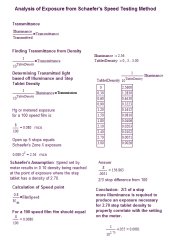Stephen,
Thank you. This is all very useful information, and I'm grateful that people that know more about this than me are willing to share. The whole reason why I'm even doing any of this is multi-fold. I recently opened up a film lab and started processing film for other people. My standard black and white development regime is replenished XTOL at 24C in a JOBO. Kodak's J-109 is a wonderful document, but doesn't cover all films available, and so if I want to process everything in replenished XTOL, I needed to come up with a way to see what a film was doing for a given development time. This is why there's the red ISO line and the green zone line. If a film at a certain time has more contrast than the red ISO line (this is why it's red), I need to pull my development time in. If it it has less contrast than the green line, I need to add development time. Ideally, it should be as close as possible to the zone line (this is why it's green). Let me show a couple of preliminary examples.
Below is Fomapan 100. 6 minutes is clearly waaaayyy too much time.
View attachment 224909
Along the way, this has allowed some insight into other things. Below is Bergger Pancro 400
View attachment 224910
I originally made the exposures metering at ISO 400, however didn't break 0.1 at -4 down. -3 down did, which tells me that this is not really a true 400 speed film. Based on the data points I have so far, it looks like 15 minutes will give ISO contrast, or close enough to it, which is not what I want, so I'm planning to do another round at ISO 200 and pull the time in by 25% to see where that puts it.
So what do I do if somebody sends me something that I haven't worked out a time for yet? This all goes by the wayside and if I can get a data sheet for the film, I'll try to use the recommended developer, temperature, and agitation in the tech sheet. What this usually means is I'll pour 300-600ml of D-76, put the roll in a Paterson tank and run it at 68F with inversions for whatever time is in the tech sheet. If I can't get a tech sheet, then I try to go by massive dev chart for D-76.
If it's a film that is currently in production that I can buy easily enough, then I put it on my list of emulsions to work out a replenished XTOL time for.
Along the way, it occurred to me that I'm not the only guy out there running film in a JOBO and using replenished Xtol, and that this might be useful to other people, which leads us to this thread.











